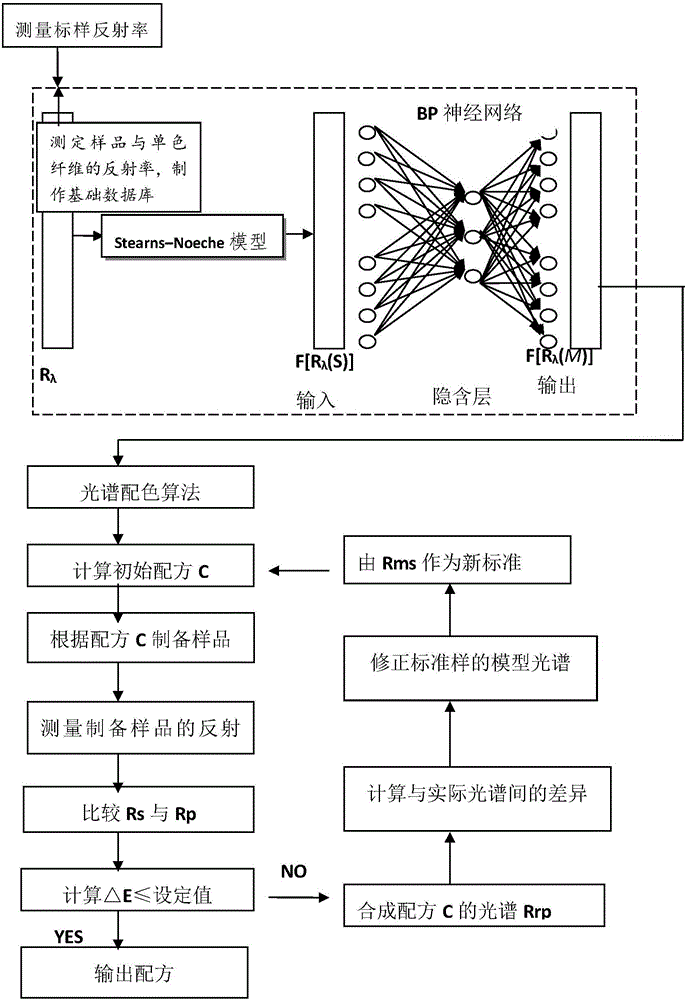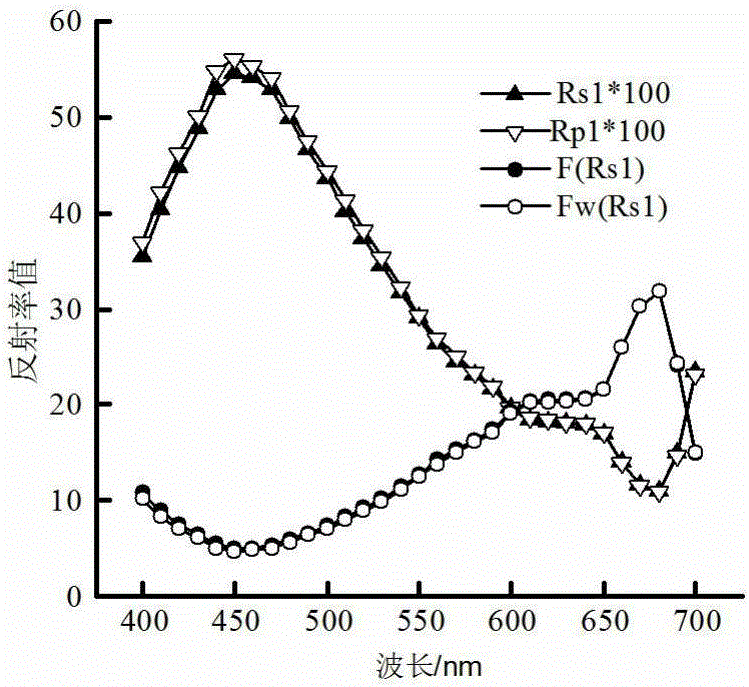Colored spun yarn color matching method based on neural network
A neural network and BP neural network technology, applied in the field of textile color matching, can solve problems such as poor applicability and poor generalization ability
- Summary
- Abstract
- Description
- Claims
- Application Information
AI Technical Summary
Problems solved by technology
Method used
Image
Examples
Embodiment 1
[0050] This embodiment relates to a method for color-spun yarn color matching based on a neural network. The main steps include: (1) measuring the reflectance of the standard sample (R5B95) and converting it into a model reflectance; the measurement uses a Datacolor600 spectrophotometer with a wavelength range of 400 ~700nm, the wavelength interval is 10nm. use R s1 Indicates that the R s1 Substitute into the formula (1) of the color matching model, and convert it into the reflectance of the standard sample model F(R s1 ). (2) Use the BP neural network to calculate the weight-average model reflectance Fw(Rs1); take F(Rs1) as the input layer, apply the trained BP neural network to calculate, and obtain Fw(Rs1), (3) use the constrained least squares The multiplication algorithm is used to obtain the prediction scheme of formula C; the weight-average model reflectance Fw(Rs1) is fitted with the monochromatic model reflectance F(Ri), and the calculation is performed under the c...
Embodiment 2
[0052] This embodiment relates to a color-spinning color matching method based on a neural network. The main steps include: (1) measuring the reflectance of the standard sample (Y25G75) and converting it into a model reflectance; the measurement uses a Datacolor600 spectrophotometer with a wavelength range of 400 ~700nm, the wavelength interval is 10nm. It is represented by Rs2, and Rs2 is substituted into the color matching model formula (1) to convert it into the reflectance F(Rs2) of the standard sample model. (2) Use the BP neural network to calculate the weight-average model reflectance Fw(Rs2); take F(Rs2) as the input layer, apply the trained BP neural network to calculate, and obtain Fw(Rs2), (3) use the constrained least squares Multiplication algorithm to obtain the prediction scheme of formula C; use the monochrome model reflectance F(Ri) to fit the weight average model reflectance Fw(Rs2), and perform calculations under the constraint conditions to obtain formula C...
Embodiment 3
[0054] This embodiment relates to a color-matching method for color spinning yarn based on neural network. The main steps include: (1) measuring the reflectance of the standard sample (W45D55) and converting it into a model reflectance; the measurement uses a Datacolor600 spectrophotometer with a wavelength range of 400 ~700nm, the wavelength interval is 10nm. It is represented by Rs3, and Rs3 is substituted into the color matching model formula (1) to convert it into the standard sample model reflectance F(Rs3). (2) Use the BP neural network to calculate the weight-average model reflectance Fw(Rs3); take F(Rs3) as the input layer, apply the trained BP neural network to calculate, and obtain Fw(Rs3), (3) use the constrained least squares The multiplication algorithm is used to obtain the prediction scheme of formula C; the weight-average model reflectance Fw(R) is fitted with the monochrome model reflectance F(Ri), and the calculation is performed under the constraint conditio...
PUM
 Login to View More
Login to View More Abstract
Description
Claims
Application Information
 Login to View More
Login to View More - R&D
- Intellectual Property
- Life Sciences
- Materials
- Tech Scout
- Unparalleled Data Quality
- Higher Quality Content
- 60% Fewer Hallucinations
Browse by: Latest US Patents, China's latest patents, Technical Efficacy Thesaurus, Application Domain, Technology Topic, Popular Technical Reports.
© 2025 PatSnap. All rights reserved.Legal|Privacy policy|Modern Slavery Act Transparency Statement|Sitemap|About US| Contact US: help@patsnap.com



